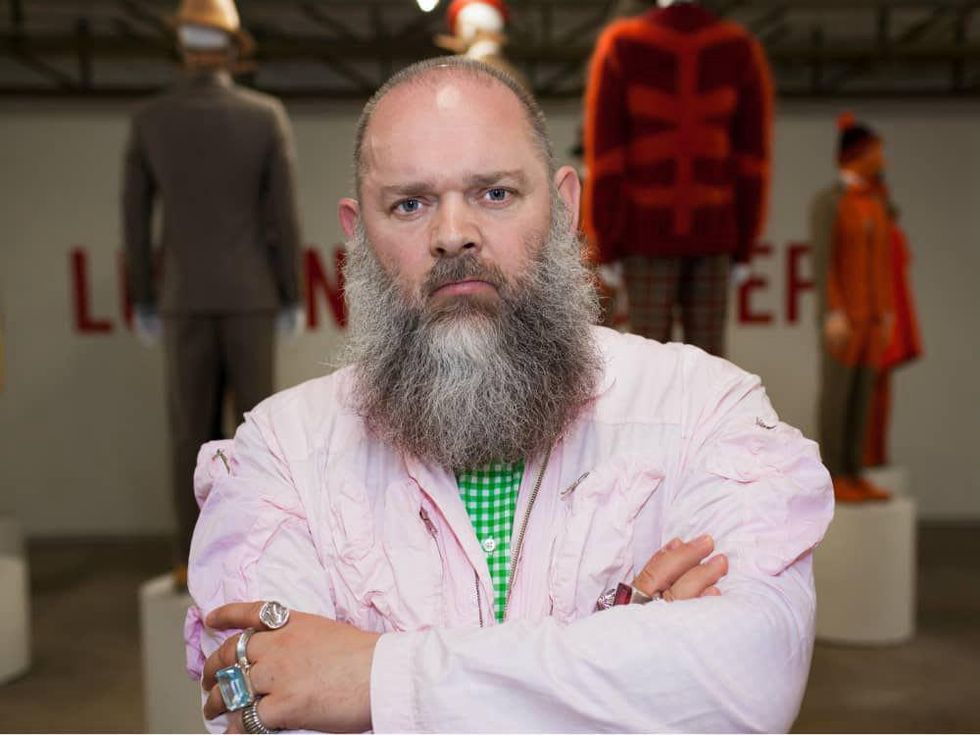Belgian Treat
Designer Walter Van Beirendonck mixes metaphors and silhouettes at Dallas Contemporary
Belgian designer Walter Van Beirendonck is a study in contrasts. Dressed in a zip-up boiler suit with knuckle-duster rings on every finger, he has a physically imposing presence with a soft-spoken demeanor.
You could say his design aesthetic falls right in line with his persona. On the one hand, his over-the-top pieces are aggressively styled with influences as varied as Papua New Guinea warriors, secret societies and Haitian voodoo. On the other, his tailoring is impeccable, with incongruous fabrics mixed and matched to create surprisingly flattering silhouettes.
The Belgian designer, who emerged in the mid-’80s as part of the revolutionary Antwerp Six collective (which included Dries Van Noten, Ann Demeulemeester and Dirk Bikkembergs), was in Dallas last weekend to install his exhibition at the Dallas Contemporary. As part of his local appearance, Van Beirendonck decked out the windows of the newly opened Traffic Los Angeles boutique — a partner in the exhibition — with images from his catwalk show in Paris on a video installation.
Although Van Beirendonck has already been honored with a full-blown retrospective in his native Antwerp, which travels to Melbourne later this year, his Contemporary show highlights his last two collections: spring/summer 2013’s “Silent Secrets” and fall/winter 2012’s “Lust Never Sleeps.” Mannequins are outfitted in ensembles that appear just as they did on the runway, twirling lazily in circles as the viewer gets up close and personal with this very singular talent.
CultureMap: It’s very rare for a designer to have work on exhibition that is still available for purchase in stores. Can you tell us how the exhibit came about?
Walter Van Beirendonck: Peter Doroshenko, the executive director of the Dallas Contemporary, asked me to show those two collections, and they were just in fact produced, which is unusual. Museums typically select out of the archive.
At one side it is more interesting to be [in stores], because you can decide on ideas easier and quicker in fashion, but it is losing its value. Art pieces have a whole life in them; fashion has a six-month cycle.
CM: This is your first time in Dallas. What are your impressions of the city?
WVB: It’s the first time I’m traveling across America. Of course, I’ve been to New York many times, but this trip I started in LA and did a lecture at the Otis College of Art and Design. I went to Chicago for a lecture and now in Dallas, which is so different.
It felt strange arriving here and seeing this big city without people on the streets. The city gives an empty impression, but I was also overwhelmed by the quality and number of museums and galleries.
CM: You still teach in addition to your design duties and exhibitions. How do you fit it all in?
WVB: Yes, I’m the head of the fashion department of the Royal Academy of Fine Arts in Antwerp. It’s easier to travel during the holidays, and we just had two weeks off for Easter! I’ve been doing it two days a week since 1985.
I resisted very quickly after graduating, but I enjoyed [teaching] and did very well — due to my fashion design, I can get into the heads of young people and guide them.
CM: Can you tell us some of your pupils who have had success?
WVB: Oh, everybody. Kris Van Assche, Veronique Branquinho, Bernhard Willhelm.
CM: And are you annoyed they make more money than you do?
WVB: Well, they definitely do better than I do, but I’m not frustrated by that. They make their careers, and I’m proud of that. I’m the daddy of the Belgian fashion world, and it’s very rewarding to be head of a school that has had that dynamic.
CM: Speaking of your school, did you know when you and the rest of the “Antwerp Six” were graduating you would have such an influence on the world of fashion?
WVB: It was very spontaneous and out of frustration to get out of Belgium. We were working for five years from ’80 to ’85 and got to go to London to the British Design show and got international attention. You don’t realize [it’s a moment], because everybody was doing their own thing. We stuck together because it was very practically easier.
CM: And do you still keep in touch?
WVB: With everyone except Martin Margiela, who has disappeared for everybody. The 7th of September this year, there’s an opening in Antwerp honoring 50 years of the fashion department, and we found a room created around the team of friendship.
CM: How do you distill the themes that influence your collections?
WVB: “Silent Secrets” was a reaction to everything that was going on in the social media world. Everything is over-visible. It’s nice from time to time for things to be more closed, but that’s a luxury you don’t have today. I tried to combine that with secret societies, which have very specific dress codes and formal clothing.
With “Lust Never Sleeps,” I wanted to create a kind of tension that you could find in Haiti in voodoo. I found books about the rituals, and I put that in with a future dandy and inspiration from Papua New Guinea.
I used warrior shield patterns and masks to create a kind of tension with all these pieces put into one. I like to mix all the ingredients and create a kind of surprise. I can talk about the check fabric I found in Italy too, which is less interesting!
---
The Walter Von Beirendonck exhibition runs through August 18 at the Dallas Contemporary.
Belgian designer Walter Van Beirendonck emerged in the mid-’80s as part of the revolutionary Antwerp Six collective, which included Dries Van Noten, Ann Demeulemeester and Dirk Bikkembergs.






